Order-Related Activities
Receiving the customer and counselling
It is important to receive the patient or customer into the sales area with a smile and a gentle manner. After welcoming the patient double-check the prescription for the following (Fig. 4.1).
- Patient’s name
- Medical record No.
- Age
- Date – if the prescription is over 6 months old - insist on a re-examination
- Power – if the power seems probable for that age group (e.g., A child, usually, should not receive a prescription for bifocals)
- Signature of the ophthalmologist
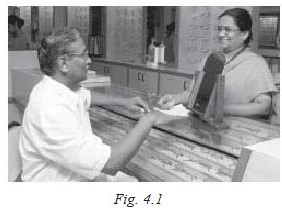
The staff should be sensitive to the needs of the patient. He should be tactful in gathering information about his or her lifestyle, occupation and habits – this will help in choosing an appropriate product.The optician should exude confidence and be knowledgeable in all products and processes of the optical section. Always remember that the patient’s welfare is priority.
While taking the order from the patient, the salesperson should:
- Listen attentively to the customer’s needs
- Explain to the customer about the prescription
- Enquire about the customer’s occupation and other habits which will help to decide the right product for him (e.g. if he actively participates in sports, you can advise lightweight, shatter-proof lenses)
- Speak clearly
- Be patient while explaining the products
- Give entire attention to the customer
- Avoid attending to more than one customer at a time – tell the next customer to wait awhile and give them some product brochures to go through
- Avoid talking to other staff
- Do not push or force the customer to buy a certain product
- Do not hurry the patient to make a choice
- Explain the price and delivery procedure clearly and ensure that the customer is satisfied with the product that he has chosen
- double check the final choice with the patient
- Suggest to the patient that it is handy to have a spare pair of spectacles or in case of bifocal wearers,perhaps an extra reading glass
- Avoid panicking and seek a senior staff for advice,when handling a difficult situation
Guiding the patient to choose an appropriate product
It is important to explain to the patient which frame or lens type best suits his needs – with respect to his prescription as well as his occupation and other activities. While guiding the patient to choose an appropriate pair of spectacles, the following should be kept in mind:
- The pupil should be near the center of the lens space to avoid looking cross eyed
- The top of the frame should not be higher than the line of the eyebrows
- The bottom of the frame should not touch the patient's cheek
- Frames should not be wider than the overall width of the patient's face at the temples
- The design and position of the bridge is important for a comfortable fit. When the bridge leaves pinch marks then the frame is too tight. On adjustable pad frames the pads can be adjusted but plastic frames need to fit as it is
- The next section suggests aesthetically suitable frame shapes for each face shape (Fig. 4.2)
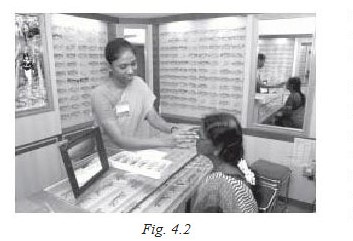
Previous spectacles
Find out from the customer, what kind of spectacles he has already been using. The new spectacles should be compatible to the old one – or else we should warn him about the adaptation time for the new glasses. (e.g. If the customer has been using executive lenses and is now buying D-bifocals – we should tell him that the reading area will be much less and that he must learn to adapt his eye to see only within the reading circle.)
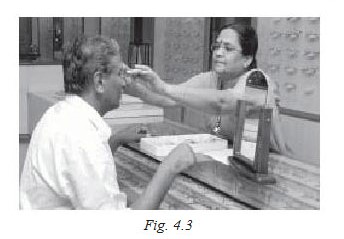
Detailing the price
Once the order has been taken, it is important to repeat the order and show the frame chosen and verify with the patient if the order is correct. Then explain in detail the price of the spectacle along with the break up (if any) into frame price, lens price, fitting charges,delivery charges etc., (Fig. 4.3).
Detailing the delivery
It is also important that the delivery method is explained clearly. Explain how and when the delivery will take place: whether the spectacles will be delivered immediately or if it will be ready for pick up on a mentioned date or if the spectacles will be delivered by mail and on what date (Fig. 4.4).
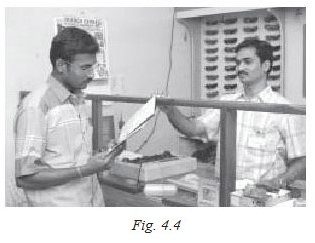
Taking measurements
While choosing an appropriate frame for the customer, it is necessary to select one that is affordable,aesthetically appealing (looks good), suitable for the lens chosen and comfortable. To ensure that the wearer has comfortable vision, the spectacles should be aligned to the eyes of the wearer for which certain measurements need to be taken. This section talks about how to choose an appropriate frame for each face shape and how to take measurements for a customer.
Here are a few guidelines for choosing an appropriate frame for each face shape:
These guidelines are only suggestive. It is more important for the frame to suit the lens type and fit comfortably.
- Oval face: This face shape is perhaps the easiest to suit. Oval faces have foreheads that are slightly wider than the rest of the face and the sides of the face narrow gently inwards towards the jaw line. Almost any style is suitable: round, oval,angular or upswept, although as with all frames attention should be paid to the fit of the bridge and the size of the frame.
- Round face: A round face is usually short and fairly wide. Cheeks may be full leading to a soft,rounded chin. Try to avoid round frames. Choose frames that are distinctive, angular, almost square,with designs that accentuate the upper part of the face. Look for frames with high temples.
- Heart or Triangular shaped: This face features a small neat chin and mouth leading up to a broader forehead. Choose angular frames with strong vertical lines. Avoid frame shapes which follow the angle of the jaw and in doing so draw attention to it.
- Square face: The square face is angular and well-defined but can be quite short and wide. It is not advisable to use square-shaped frames. Instead soft round frame shapes or large ovals are advisable.Small styles should be avoided as these will only emphasize the squareness of the face
- Long face: The long face is characterized by high cheek-bones, a deep forehead and a strongly defined sharp chin line. The long shape can benefit from enhancing the width of the face so try wide,large framed glasses in oval or round styles
Back vertex distance and lens effectivity calculations
The Back vertex distance is usually measured between the front surface of the cornea and back surface of the lens. The normal vertex distance of spectacle lens is about 12mm.
When the convex lens moves away from the cornea, its effective power increases and towards the cornea its effective power decreases (Fig.13.17).Similarly a concave lens moved away from the cornea its effective power decreases. When it moves towards the cornea its effective power decreases. When a patient is tested at 12mm vertex distance and found to have 12.0D Sph error and vision is 6/6 by moving the lens the vision is reduced. This is because the effective power is changed. Vertex distance at the time of testing must be equal to the vertex distance after wearing the spectacle. The vertex distance measurement is very essential for all high refractive errors. The distance is measured by means of an instrument called as, ‘Distometer’.
Lens optical effect may vary with vertex distance that causes poor visual performances i.e., decrease of vision. If moves away from eye, the effectivity of the ‘+’ lens becomes stronger and becomes weaker in ‘-’ lens
Example
If the vertex distance is not the same, appropriate correction in the power is required as given below
1. A patient is refracted at 15 mm and prefers to wear a -10.0 D of his glass at 10 mm. What is the effective power in the position.
- f'v -10 -10
Fe =------------ = ------------- = ------------ = 10.57D
1- df 'v 1-(-0.05)(-10) 1- .050
2. A patient found to have a +8.0 D at 15 mm and now the patient wants spectacle at 11 mm what power should be ordered.
- +8
F = ----------------- = +8.25D (d is +ve)
1-(.004) (+8)
3. Patient expresses desire for contact lens of -6.5D power tested at 15 mm .What power to be ordered for contact lens.
- -6.50
Fe = -------------------- = -5.9D
1-(.015)(-6.5)
4. Refraction of an aphakic eye is performed at a vertex distance of 13mm and shows need for +12.0DSph. If the lens is now dispensed and worn at 17mm from the cornea. What is the effective power of the lens in this new position.
- +12.0
Fe = ------------------ = +12.605D (d = +.004)
1-(.004) (+12)
Interpupillary distance (IPD)
Interpupillary distance, the distance between the centre of the pupils, is measured in millimeters. This measurement should be obtained both at distance and near for each patient. Both a binocular measurement (a single recording of the total distance from pupil to pupil) and a monocular measurement (the individual distance from the center of the bridge of the nose to the center of each pupil) should be recorded.
In orthophoric (normal) patients, the eyes look straight ahead when they focus on an object directly in front of them. Eyes that are straight in the primary gaze (straight ahead) will have virtually parallel axes when they fixate on a distant object. However, when the same pair of eyes focus on a near object, the eyes converge (turn in slightly) to allow both foveas to fixate on the object. Because of this convergence, the near IPD will be lesser than the distance IPD.
The distance IPD measurement is required to fit the power spectacles both single-vision and multifocal. The near IPD measurement is required when single- vision or multifocal eyeglasses are prescribed for reading or other specified near tasks. The accurate measurement of both distance and near IPD ensures the appropriate placement of the optical centers of the eyeglass lenses. If the distance between optical centers (DBOC) does not correspond to the patient’s IPD, the patient can experience double vision.
Therefore, the OA should verify the correct IPD and DBOC for all eyeglasses, whether they are new prescriptions or eyeglasses brought in by patients with vision complaints (Fig. 4.5).
Several methods exist for measuring distance or near IPD. In addition, either binocular or monocular
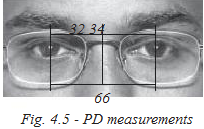
measurement may be chosen. Monocular measurement of IPD is considered more accurate than binocular measurement because the monocular recording takes into consideration any facial asymmetry that might be present.
A binocular distance IPD requires just one pupil- to-pupil measurement made with a millimeter ruler. For a monocular distance IPD measurement, the distances between each pupil and the bridge of the nose are measured separately and the results are added together to yield a single measurement. Simple and accurate monocular IPD measurements may be made with a specially calibrated ruler and a penlight.
Both binocular and monocular near IPD may be measured or calculated. Measuring the binocular or monocular near IPD requires both the millimeter ruler and the penlight.
Measuring monocular distance PD
- Position yourself 40cm in front of the patient.Make sure your eyes are level with the patient’s eyes. Hold the IPD ruler lightly over the bridge of the patient’s nose.
- Hold a penlight under your left eye, aiming the light at the patient’s eye. Note the position of the spot light reflection called the corneal reflex on the patient’s right eye , and record the number on the ruler just below the reflex. This represents the number of millimeters from the patient’s right corneal reflex to the center of the bridge of the nose.
- Hold the penlight under your right eye, aiming the light at the patient’s eye. Observe the corneal reflex on the patient’s left eye. Record the number of millimeters from the left corneal reflex to the center of the bridge of the nose (Fig. 4.6).
- Add the two numbers together and record the sum on the patients chart or form as appropriate.

Face measurements
An Inaccurate size frames greatly affect the overall cosmetic appearance and comfortness of the wearer. In order to fit the spectacles correctly, some technical measurements need to be taken.
Face measurements are taken to choose the appropriate size frame and to hold the spectacle in place. An optician’s ruler is a device used for it.
The measurements are
- Bridge size: This is the width of the bridge of the nose
- Intra temporal distance: This is the distance between the temples
- Temple length: This is the distance between the temple and the top of the ear (Fig. 4.7).
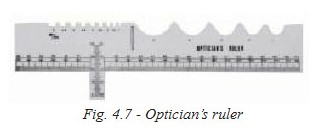
- Pantoscopic tilt: This is the angle between the normal to the temple and the frame front
- Vertex distance: This is the distance between the front of the cornea and the back of the lens
- Segment height: The reading segment should not be placed more than2 mm below the lower eyelid and the frame should be large enough to accommodate at least three-fourths of the segment area to enable comfortable near vision.
Progressive lenses need to be fitted with an additional care as the patient will be sensitive to even slight changes.
Progressive addition lens dispensing
- Frame Selection:In PAL lenses, the fitting of the lens needs to be accurate; the patient will be sensitive to any small change as it will cause him to see through the distorted area or in the wrong power zone. Thus frames must be chosen appropriately.
- - Type: Metal frames are a better option for PALs because fitting heights can be adjusted,if required, using the nose pads.
- Height of the frame: Frames must also have sufficient depth (B measurement) to the rim (>22mm below pupil, >14mm above pupil) to ensure adequate area for distance and near
optical zones.
- Shape: Another important factor in frame selection is ensuring that the shape of the frame does not reduce the size of the reading area by
being too “cut away" in the nasal area of the frame. E.g., an aviator style frame (Ray ban shape) coupled with a narrow PD may not be
able to accommodate the reading area
- Taking the Measurements: Facial fit must be optimized before taking measurements so that fitting heights can be correctly measured. Adjustments like facial wrap and pantoscopic tilt must be performed prior to PD measurements.While taking measurements, let the patient wear the frame as he usually would. The patient’s PD is measured by a PD ruler or pupilometer (as described previously) and using the following method the PAL marking are made:
- - The base of both eyewires of the frame are first aligned on same level by verifying with one of the horizontal lines on the layout card
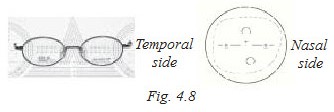
(which is usually issued by the PAL manufacturer) (Fig. 4.8).
- The frame is centered on the card by ensuring that the No. of slanting lines below the bridge are equal for both eye wires.
- The PD measurement is now marked using the mm graduated ruler given.
- The frame is lowered to align with another horizontal line and the same process is repeated.
- A straight line is drawn connecting the two points for each eye.
- The pupillary centre is marked on this line with the help of the corneal reflection.
- Verify the centre once again. Now, the frame is again held against the layout card positioned to align the vertical line with the one in the card and the fitting cross coinciding with the pupilary centre marked (Fig. 4.8).
- Now ensure that the reading circle lies well within the eyewire with a fitting height of at least 22mm (fitting height is measured from the fitting cross to the bottom of the eyewire) and that there is at least 14mm between the fitting cross and the top of the eyewire. These specifications may change for other progressive lenses like short corridor PALs (fitting height is only 14mm).
Order entry
Every order has to be recorded carefully. Ensure that the following criteria are taken during order entry:
- - Unique order number
- Order date
- Patient’s name (along with MR no. if necessary)
- Prescription power
- IPD
- Lens details
- - Material: Glass or plastic; Hi-index etc
- Design: Kryptok, D Bifocal, Progressive etc.,
- Coatings: ARC, SRC etc.,
- Tint: Photochromatic, Black etc.,
- Price
- Frame details
- - Brand name
- Model name or number
- Colour
- Size
- Price
- Fitting Charges (and any other extra charges)
- Advance amount received (if applicable)
- Delivery date and time
- Delivery Method: Direct, Mail etc
Some of the above details may not be relevant and there may be others that are. It is important to ensure that all necessary details are recorded in order to ensure that the order can be verified during delivery. If the customer has to collect his spectacles at a later time or date, it is advisable that he is given a slip with his order details, which he can use to claim delivery of his order.
Delivery
At the point of delivery of the orders for spectacles,it is necessary to ensure that the order is ready for delivery before the mentioned delivery time and date.The spectacle must not only have been fitted, but it should also have passed an overall quality test
Final spectacle quality test
The spectacles should be checked for the following criteria before delivery:
- - Check if the lens matches the prescription’s specifications - power and axis
- Check if the finished spectacles has the frame and lens mentioned in the order form
- Check for lens defects:
- Centering
- Optic centre should coincide with the measurements taken
- No scratches, waves or bubbles should be present
- The lens should fit well into the frame without gaps or chipping
- Segment height in both lenses should be equal
- Check the pantoscopic angle of the frame - Both rims must be tilted at the same angle
- Final frame adjustments to make it stable:
- Both rims and both temples must rest equally on a flat surface
- Both nose pads should be adjusted to the same angle
The delivery procedure should include the following
- - Review pending orders so that orders are readied before their delivery time
- Arrange the spectacles that are ready for delivery in such a way that it is easy to find when the patient arrives: one method is to arrange them according to the order number
- If the delivery is to be made by mail, ensure that they are dispatched on time
- When the patient arrives, greet him and help him try on his spectacles
- If the order is not ready yet, apologize politely,explain the reason for the delay and give a future date or time for delivery
- - If you have the patient’s contact information it is advisable to inform him ahead of time about the delay in delivery
- Collect any further payments that are due and prepare the bill Any further adjustments of temple and nose pads, to make it comfortable for the patient, should be done with his feedback after he tries the spectacles
- Counsel the patient about how to use and maintain his spectacles
- Encourage him to contact you if he has any problem with the spectacles
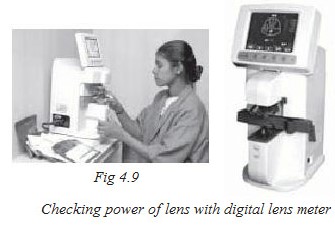
Final adjustments at delivery
When the patient tries on his spectacles, adjust them so that the following fitting errors are avoided:
- - Glasses do not stay in place
- Temples are not on the same level
- Frames sits too high or too low
- Frames touch the eye brows
- Eye wire touches the cheek
- Lens touches the lens
- Lashes unequal distance from lens
- One lens higher than the other
- Both segments not in line
- Segments seem too high
- Pads do not rest evenly on the nose
- Pads cut nose at one surface of pad – the pad pressure is uneven
- Pain is felt at the ears or behind the ears
- Verify the PD once again. In PAL lenses, before removing the temporary painted marking, ensure that the fitting cross coincides with the pupilary centre.
Counselling during delivery of spectacles
- - If the patient is wearing a certain type of lens for the first time, explain about the adaptation time
in learning to focus with the new type of lenses
- Encourage him to keep the spectacles in a case when not in use and never put lens down on any surface or without a case in a pocket, especially if it is a plastic lens.
- Encourage him to put on and remove the spectacles with both hands
- Teach him to clean the spectacles with a soft cloth and cleaning solution (Fig. 4.10).
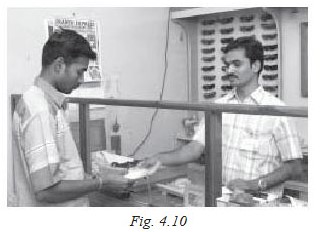
Outreach activities
Dispensing spectacles at outreach camp sites is essential to ensure that the patient who needs refractive correction actually procures a pair of glasses. Here, as the patient is sought out to deliver the service instead of him seeking eyecare, it is even more essential to see that he receives a pair of spectacles at the same place. This means that spectacles must be delivered at the camp site it self along with the refractive screening services.
Some institutions dispense readymade spectacles – which offer a range of powers in standard frame designs. Though this offers the patient the required correction it may not fully satisfy his need for a unique-looking frame.
An ideal and workable optical dispensing outreach set up involves
- - Screening facilities
- Offering a reasonable range of lenses and frames
- Spectacle fitting facilities
Staffing and inventory
For an average camp seeing 500 outpatients, the expected No. of orders being 50, the following resources are needed:
- - 1 sales person
- 1 technician
- Assortment of frames - 150 nos. (3 x no. of orders)
- Inventory of lenses - 500 nos. (10 x no. of orders)
- With the proper set of powers it is possible to deliver up to 85% of the orders on the spot. Thus,the inventory should be fine tuned with experience to achieve maximum on the spot delivery.
Edging & fitting equipment
Manual edging machines and frame warmers are portable and can be handled easily with basic power supply. Trial lens set, chipper, cutter, screwdriver and adjustment pliers complete the kit. Auto edgers are more sensitive and are not very portable. But they can be mounted and fixed to a van or truck to act as a mobile dispensing unit.
Planning
With this modest dispensing kit it is possible to fit and deliver up to 85% of the spectacles on the spot. However, this is possible when we are able to predict the quantity of orders and the powers and types of lenses likely to be prescribed. Orders for special lenses and powers for which lenses are not stocked are booked and delivery of the spectacles can be through mail.
Spectacle maintenance services
The following maintenance services can be offered to the patients at the dispensing showroom. This assures customers that they can rely on you for all their spectacle-related requirements and they will be encouraged to come to you when they need a new pair of spectacles. This range of services should ideally include all products, spares and services relating to spectacles; some of these can be offered free of charge. A few are suggested here.
- - Spectacles cleaning service: Spectacles tend to collect dirt at the nose pads and temples and even
along the eye wire. First the lens is removed from the frame and using a soft brush or an ultrasonic
cleaner, the dirt is removed. Remember to warn the customer that if the frame is very old or of
poor quality, it might get damaged while cleaning.
- Spectacle repair service: Frame parts such as the earpiece, nose pads, hinges etc might need to be replaced over time. If an assortment of such spares is stocked, then the repair work can be done on the spot. A few suggested spares:
- Nose pads
- Earpieces
- Hinges, hinge springs
- Tools: screwdrivers, pliers, frame warmer
- Accessories: Spectacle accessories can also be offered at the optical dispensing unit. A few of these have been discussed in the next section.
Spectacle accessories
Ones experience with spectacle wearing can be improved in small ways. These accessories help to make it easier, more comfortable and easy to maintain. Some accessories are meant to be therapeutic.
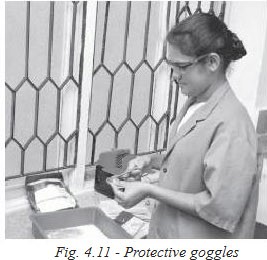
- - Sunglasses: Most customers expect to find protective eyewear at any spectacle dispensing unit; they also believe that the quality is better
here. Thus it is important to stock plano sunglasses and protective eyewear – these come
in many fancy shapes and designs.
- Protective Eyewear: These are worn to protect the eyes from harmful rays like UV or welding rays especially in an industrial setup or from harmful objects such as those worn by carpenters etc. For protection against rays the lens material and tint should be chosen to filter the particular ray. Polycarbonates are commonly used for protection against objects as they are impact resistant (Fig: 4.11).
- Rope/Chain: this goes around the wearer’s neck and is attached to the temples of the frame. When the spectacles are not in use it can hung from the wearer’s neck.
- Belt: This helps to keep the frame in place. It is an adjustable elastic band that goes around the head. It is usually used by young children and the elderly (Fig. 4.12)
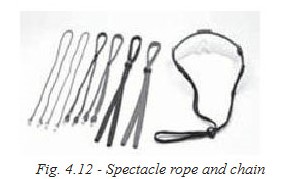
- Cleaning cloth: this should be given to all patients.This is a soft cotton cloth that is absorbent and it is used for removing dirt and oil from the lens surface. Nowadays, this cloth is also made of synthetic microfibre.
- Cleaning solutions: This is an alcohol based solvent that helps remove dirt and oil from the lens surface and some solutions can even temporarily make the lens surface anti-static which keeps the dust off. Remember that some solutions are not advisable for anti-reflection coated lenses.
- Case or box: When the spectacles are not in use,they can be stowed away in a box or case. This avoids dust collection and scratching and in the case of a box even protects it from damage from
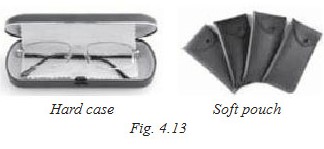
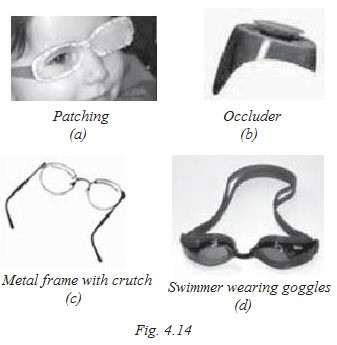
impact. Boxes are usually made of plastic or metal. Soft Cases are made of synthetic rexin or leather (Fig. 4.13).
- Occluder: This is prescribed for pediatric patients who have lazy eye. This is a cloth patch or rubber cup that covers or “occludes" one eye so that the child is forced to use the other eye (Fig. 4.14a,b).
- Crutch frame: This is an appendage to a normal frame that helps to hold the upper eyelid more open – for ptosis or ‘drooping eye’ patients. The crutch is a piece of plastic (shell frames) or a wire mounted on to the rim (metal frame) that is usually welded or glued to the top of the frame to hold the eyelid in the correct position. The position of the crutch should be specific for each patient (Fig. 4.14c).
- Swimming goggles: These protect the eyes when underwater. It also enables better vision by locking in air in front of the eyes. They come with a band that fits tightly around the head (Fig. 4.14d).
Student exercise
1. It is important to know what type of spectacles the patient is already wearing (True /False)
Answer the following
- How should one verify the prescription before taking the order.
- While taking an order what are the details that have to be recorded.
- What kind of inventory should be maintained for offering spectacle repair services.
- What are the different spectacle accessories, relevant to your location, which you must offer to your customers.
- How would you plan to offer spectacles at out reach camps.
- What is the role of the dispensing optician.
- What are the conditions for choosing a frame for PAL lenses.
- What precautions should be taken while measuring pupilary distance.
- Explain the procedure of quality checking prior to delivery.
